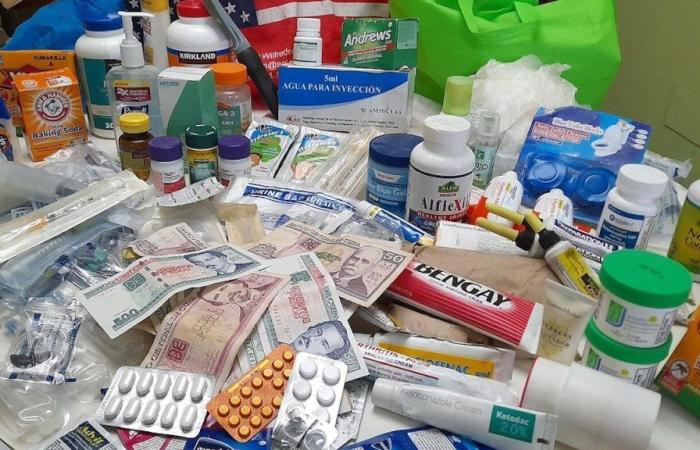“The clandestine pharmacies and illegal medicine sellers are the support to face the diseases that circulate in Santiago de Cuba“said Elsa Méndez when summarizing the odyssey she suffers to protect her family in the midst of the current health crisis.
Resigned by the circumstances, this Santa Ursula resident added that “the black market is the true winner“, despite the fact that the Government continues to present Cuba as a medical power and its health services as free and affordable for all.
Like many people from Santiago, Elsa points out that “here you die of the disease or the prices kill you,” because the shortage of medicines in state pantries leaves patients at the mercy of supply and demand.
Madelaine, a neighbor who accompanied her, was debating between “paying for a bottle of antibacterial gel at 900 pesos, a bottle of menthol at 1,200, and 100 units of paracetamol at 3,000,” or letting the fever caused by the Oropouche virus There was no solution to the health of her husband and sister-in-law.
When asked about the method of payment, the salesperson responded that it could be “by transfer or in cash”, reflecting the tranquility with which illegal sellers operate.
“Let’s cry that the tea was lost,” Madelaine exclaimed, not only because the total amount (5,000 pesos) of what she needed to buy is double or triple what the products cost weeks ago, but because it exceeds her price by 1,000 pesos. salary in the Beverage and Liquor Company.
Arturo, who was witnessing the scene, commented that he had just paid 9,000 pesos for three blisters of amoxicillin, and he was still missing “the tape, the dies, the vitamins, the syringes and the mochitas” that would cost him another 7,900. His wife, admitted, urgently needed these resources.
In other clandestine pharmacy Noemí valued the 70% alcohol that sold for 400 pesos, the hypochlorite bottles at 150 pesos, the jars with 100 Omega3 capsules at 3,200, or the catheter that would solve her brother’s urinary incontinence at 4,200 pesos.
“There are no other options to obtain high quality and imported medicinesthe State falls short,” reflected Miguel, a senior citizen and resident of Boniato, an area where there is transmission of dengue and oropouche.
A retired ophthalmologist from the Santa Bárbara neighborhood noted that “The shortage leads to buying drugs of all kinds on platforms such as Revolico, WhatsApp groups and Telegram, sometimes expiredwithout adequate conservation and at prices that easily multiply by 50 the original.”
The province has a deficit of at least 200 lines within the basic medication tablebut on the black market you can find vitamins, pain relievers, ointments, antifungal ointments and even antibiotics.
Clandestine pharmacies
Apart from street vendors, who generally sell nationally manufactured drugs on the black market, About three years ago in the city of Santiago de Cuba, as throughout the Island, private pharmacies have proliferated. Its appearance occurred after the Government authorized travelers to bring in medicines at no additional cost to the approved weight for luggage.
“At first everything was improvised. Then we studied the market and understood that the situation, instead of improving, would immediately worsen. That’s how it came about a business that solves a problem. If we did not exist, the panorama would be apocalyptic for the State“said the owner of one of these irregular pharmacies, who asked to remain anonymous.
“Little by little we became irreplaceable,” he added, “to the point that, Currently, in Santiago de Cuba, more than 50 clandestine pharmacies fulfill the mission of Government establishments.who don’t offer anything.”
““We import all the merchandise and now even small and medium-sized businesses (MSMEs) participate.”, said. Everything is done discreetly, in indoor locations and with the support of social networks.
When referring to prices, he explained that they depend on inflation and variations in the dollar. “Our cost sheets cover all expenses. Keep in mind that for a ticket to Contramaestre, which was worth 18 pesos, now truckers ask for 1,200, and that is to travel like a sardine in a can.”
Doctors think
A doctor from the Juan Bruno Zayas Hospital recognized that Analyzing the issue of private pharmacies is complex, “because along with the suffocating prices, they are the option that the people have to protect against disease.
“Tears almost come to my eyes when I see patients paying 1,000 pesos for a bulb of penicillin, 800 pesos for insulin or 4,000 for a box with 50 glucose test strips“, he listed.
“Maybe We will never know the number of deaths from a perfectly treatable disease.that They could have been saved if they had access to medicines in hospitals,” added the doctor, who asked not to be identified.
Products such as asthma devices, drugs for indigestion and stomach discomfort, as well as baking soda, antihistamines, diclofenac and antifungal cream and insecticides are only found on the informal market.
“Another great absence is permethrin, which cures scabies and there are outbreaks throughout the province. We have gone from the sublime to the ridiculous. Every day we receive brutal pyodermatitis, with terrifying infections. People go crazy, scratching themselves to the bone and the only solution is to go with individuals,” said the doctor.
An orthopedic doctor at the Provincial Hospital recognized that “patients with arthritis and polyneuropathy, which are degenerative and can only be compensated with injections of vitamin B complex and thiamine hydrochloride, have not had relief for their ailments for a year“.
“Sometimes we cannot perform infiltrations, the joints continue to swell and the pain is horrible,” he added.
He remembered that Those who suffer from Parkinson’s have a hard time finding levodopa and carbidopawhich have been missing for nine months.
Both specialists agreed that Doctors are facing extreme situations, and have great exhaustion mental due to the poor working conditions and the difficulties they overcome to heal people.
They stated that pediatric and maternity hospitals are more protected, but sometimes they only have serum to hydrate patients.
In adult centers there is not even anything to combat pneumonia. Sometimes they put patients with different infections together and that’s how the days pass, because the wards are packed. For hypertensive emergencies there is no furosemide, nitroglycerin or even heparin.




